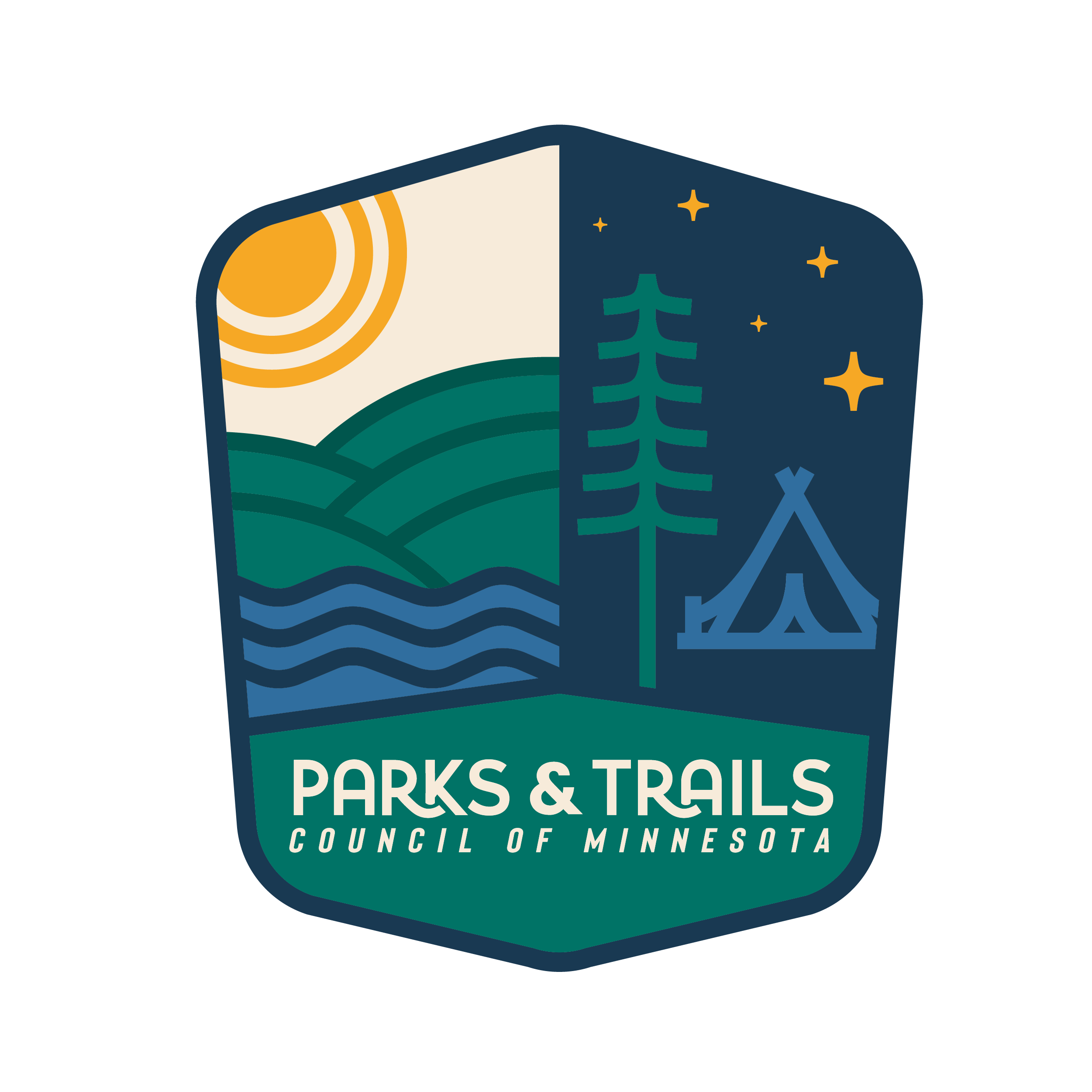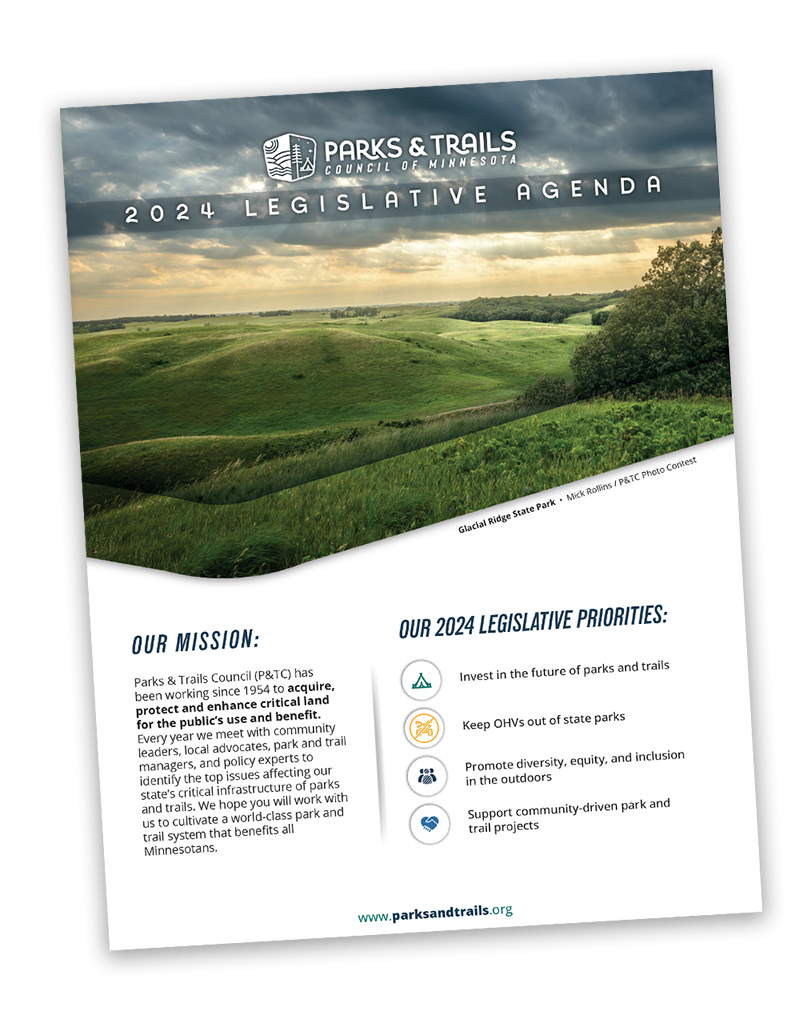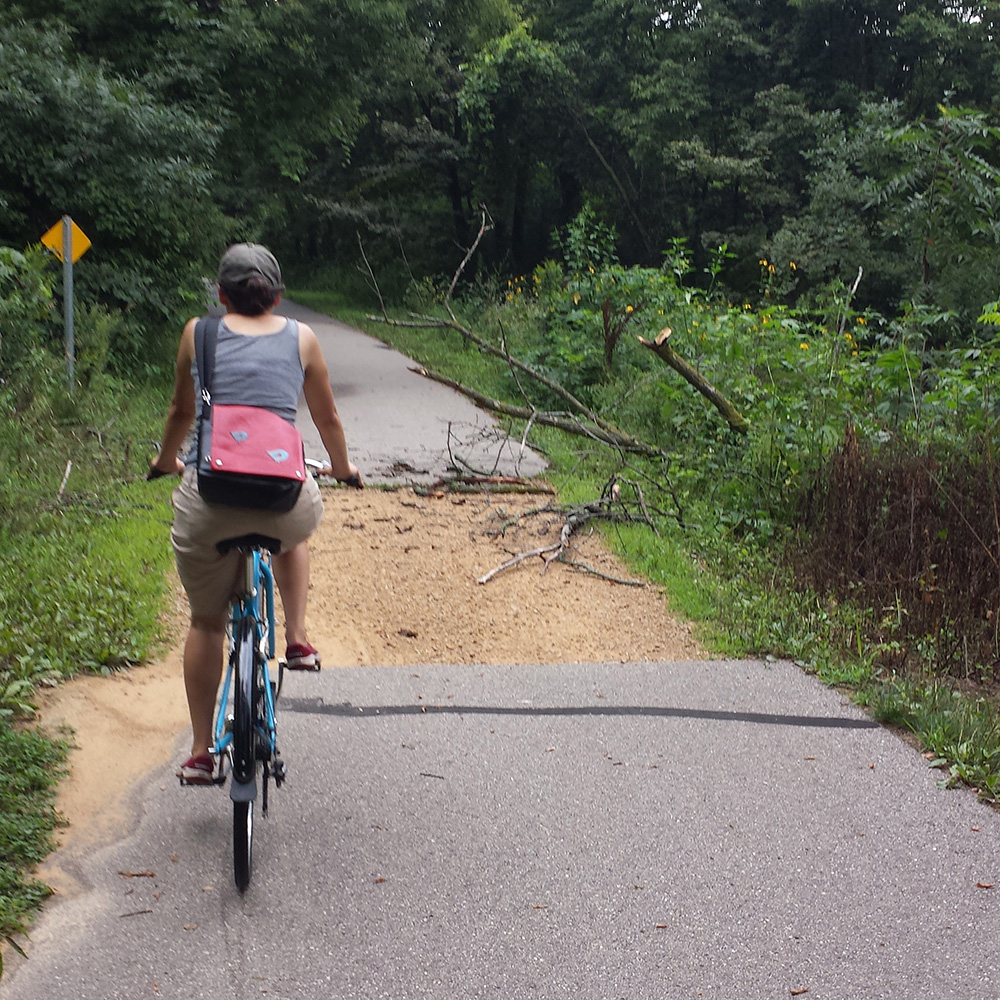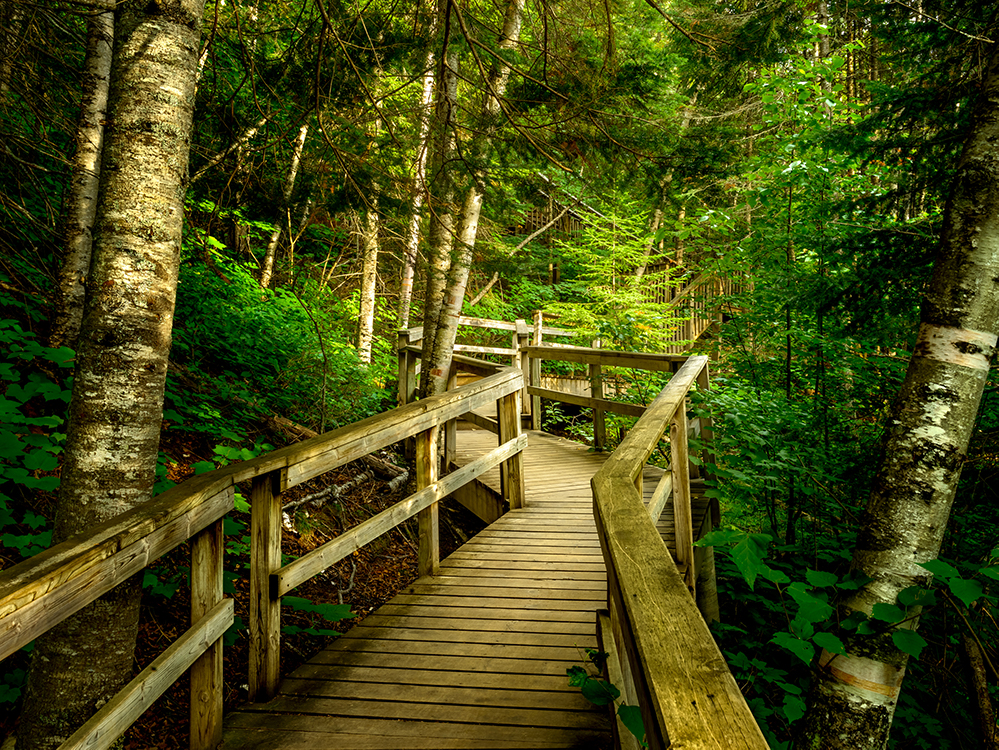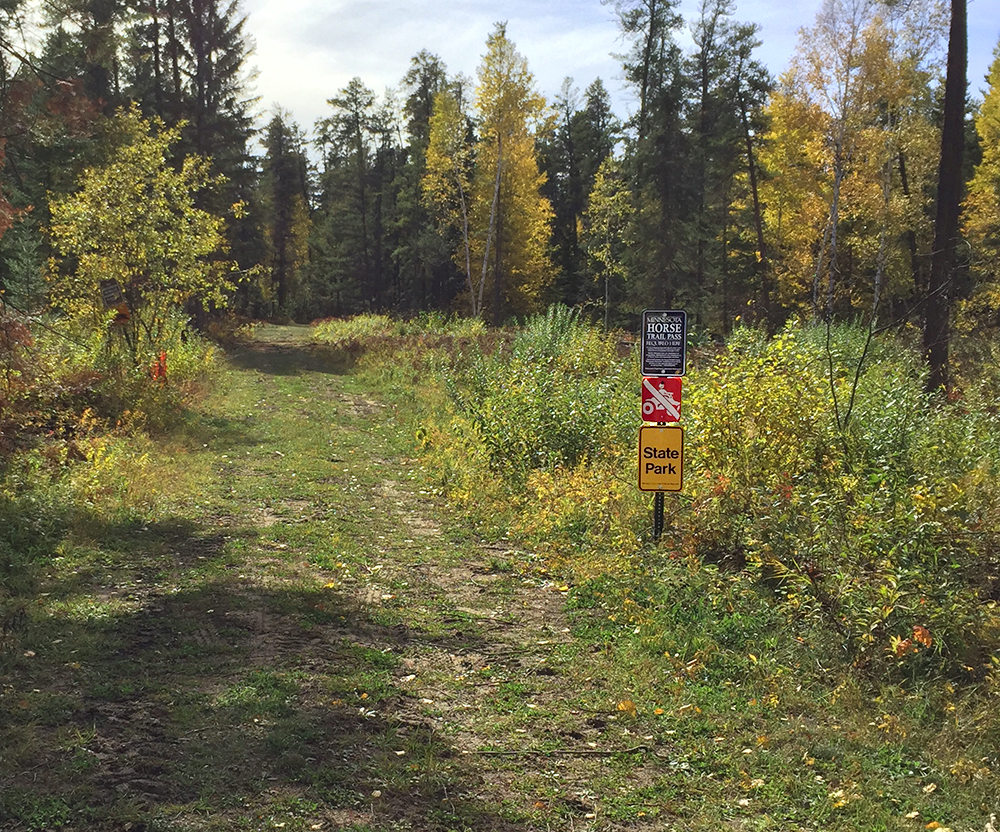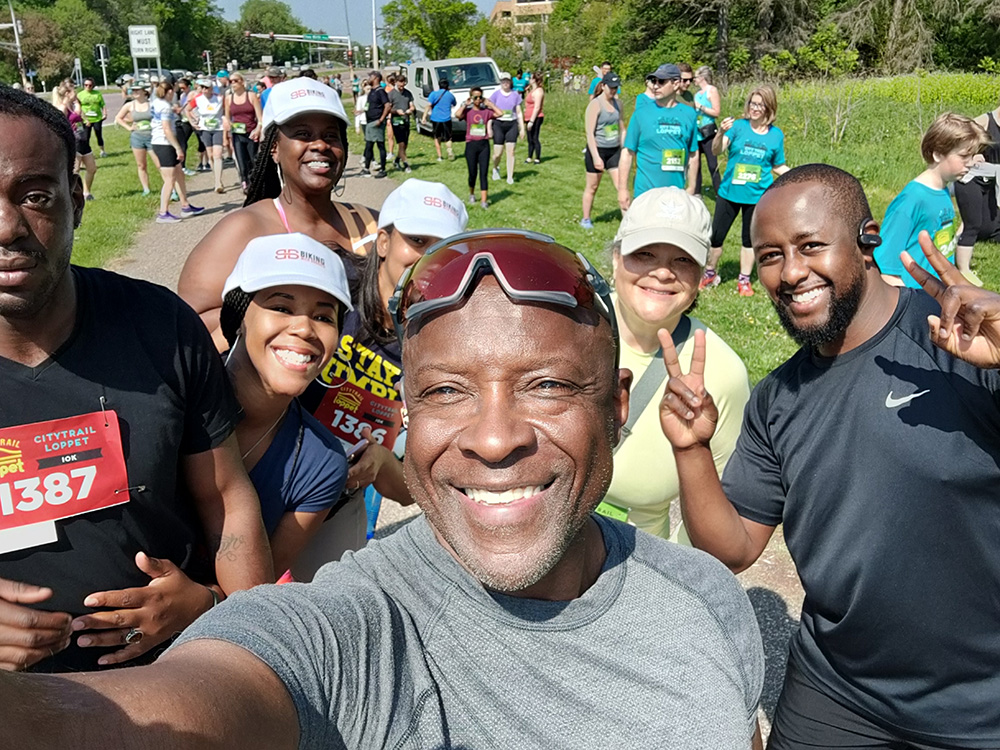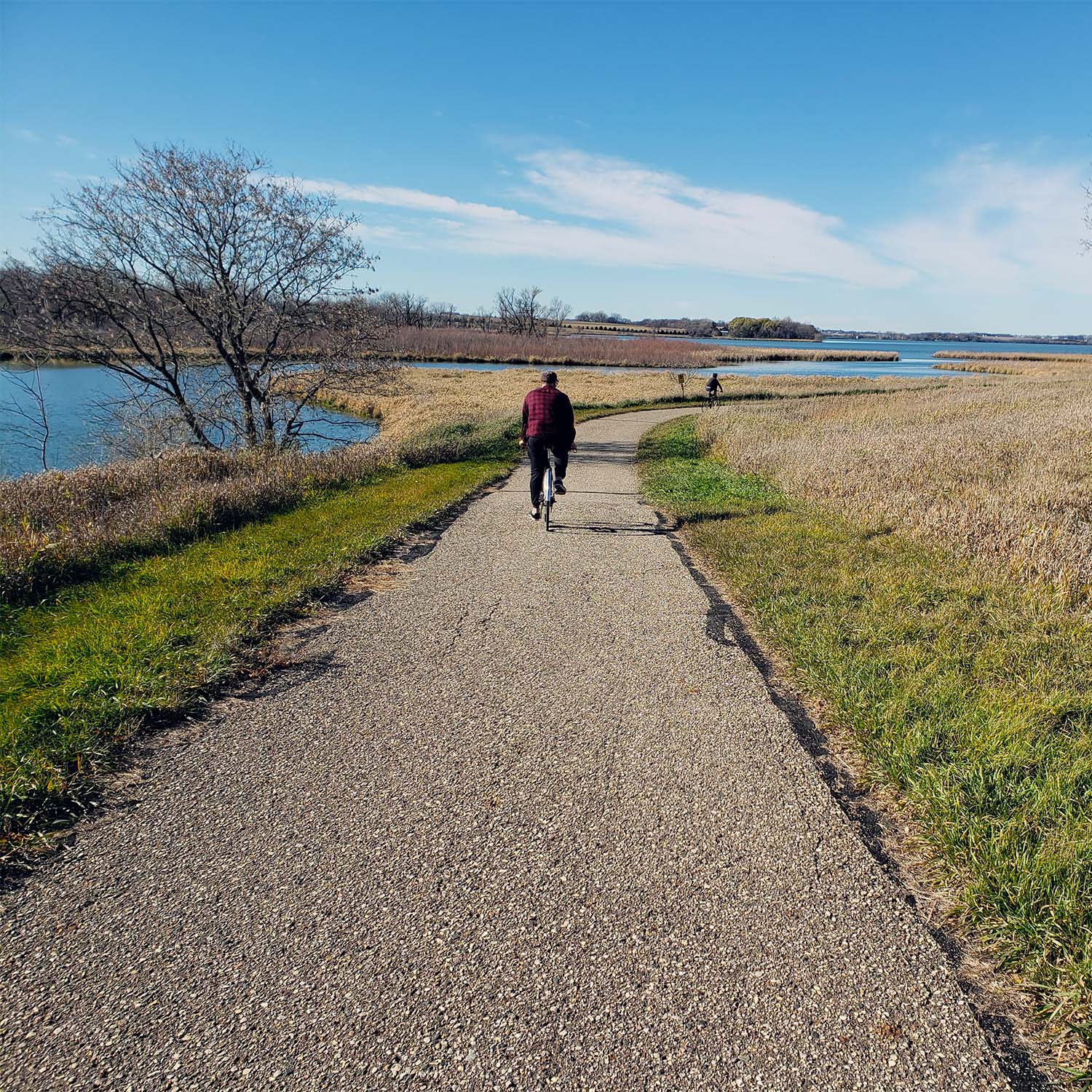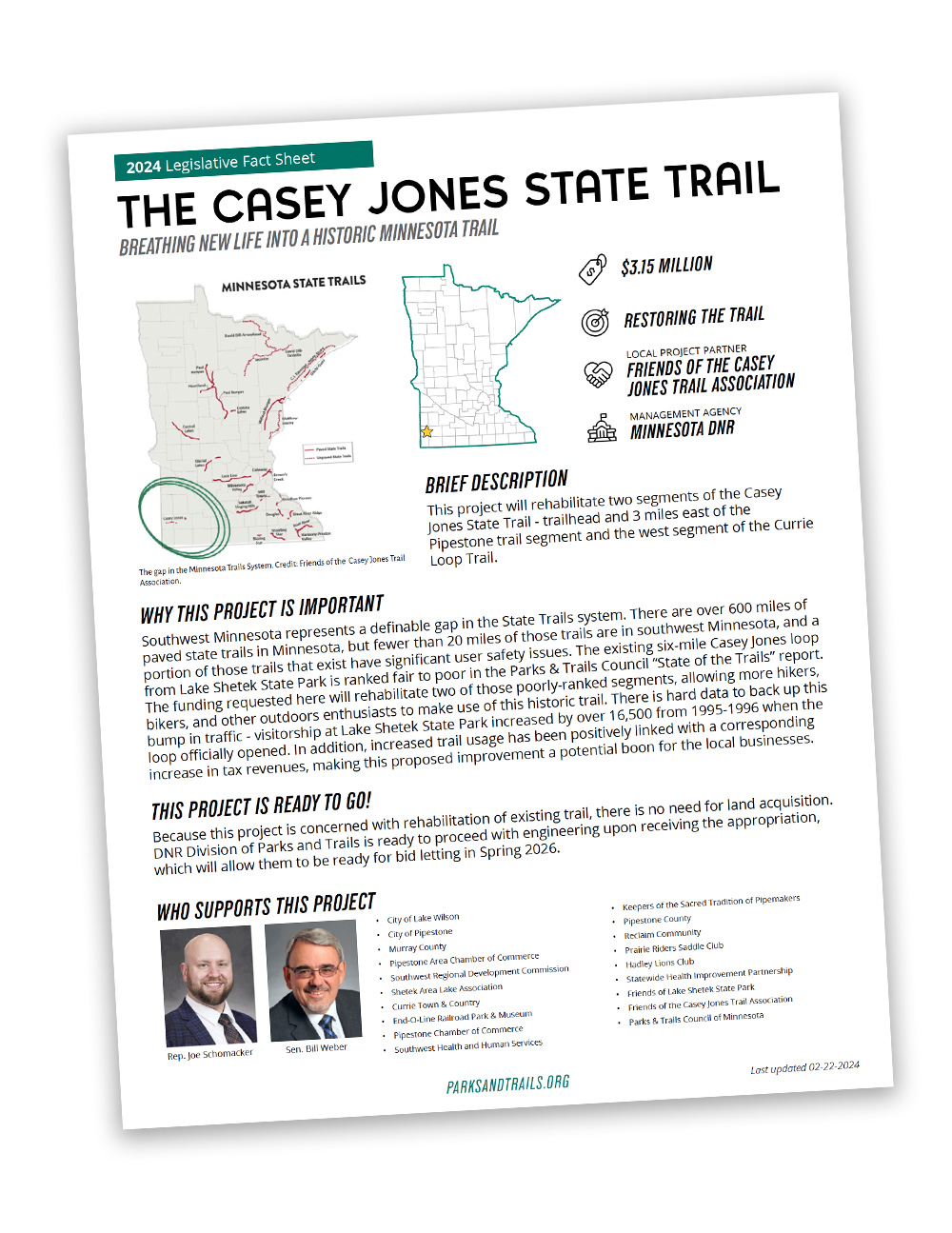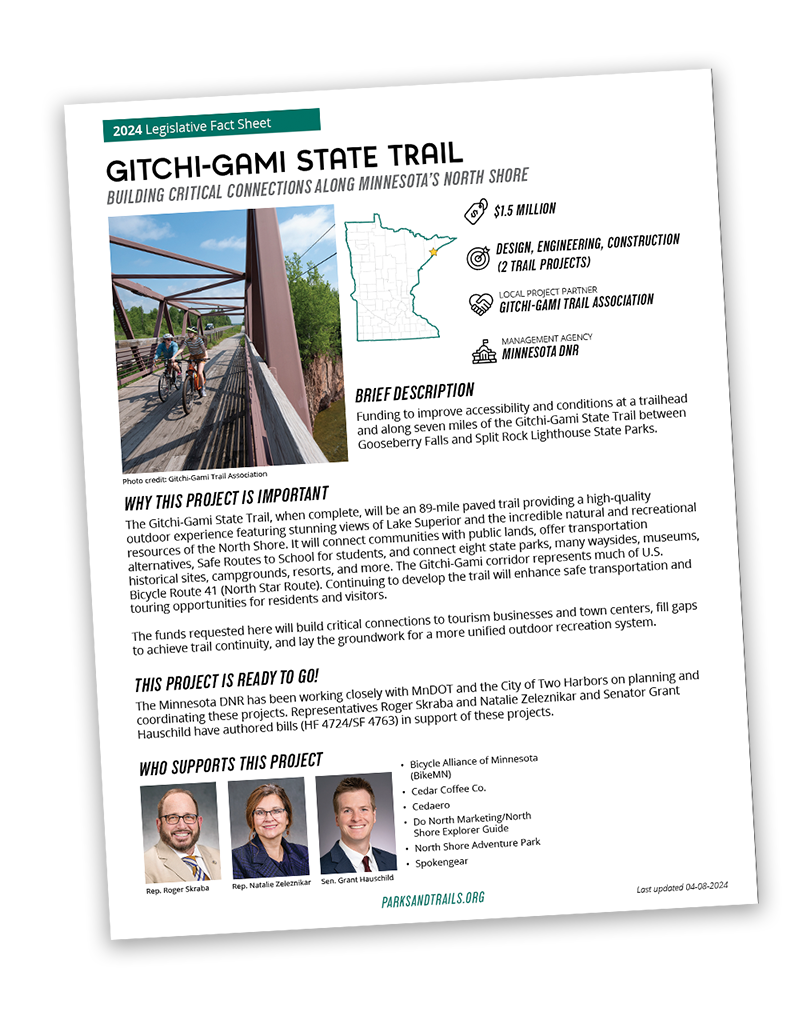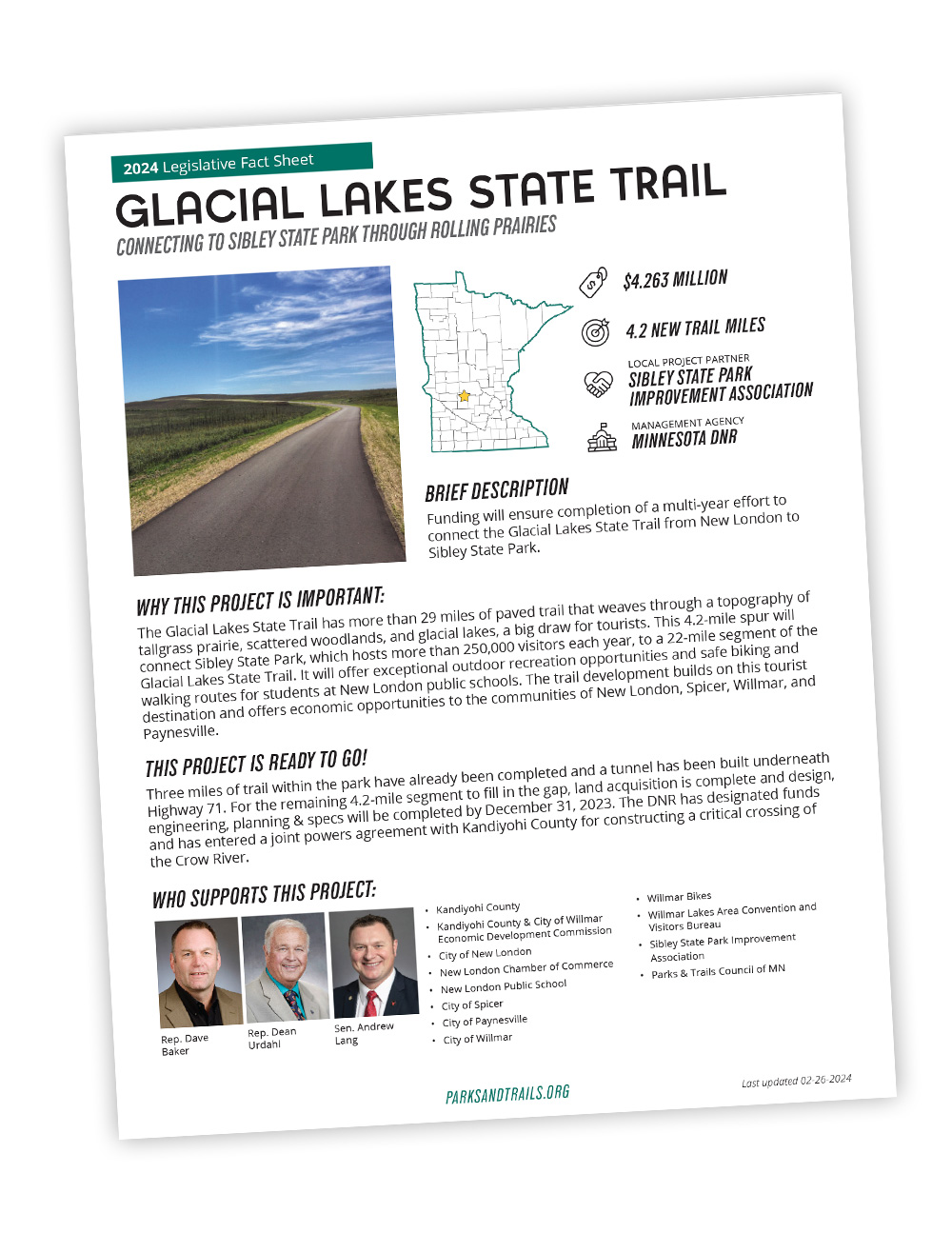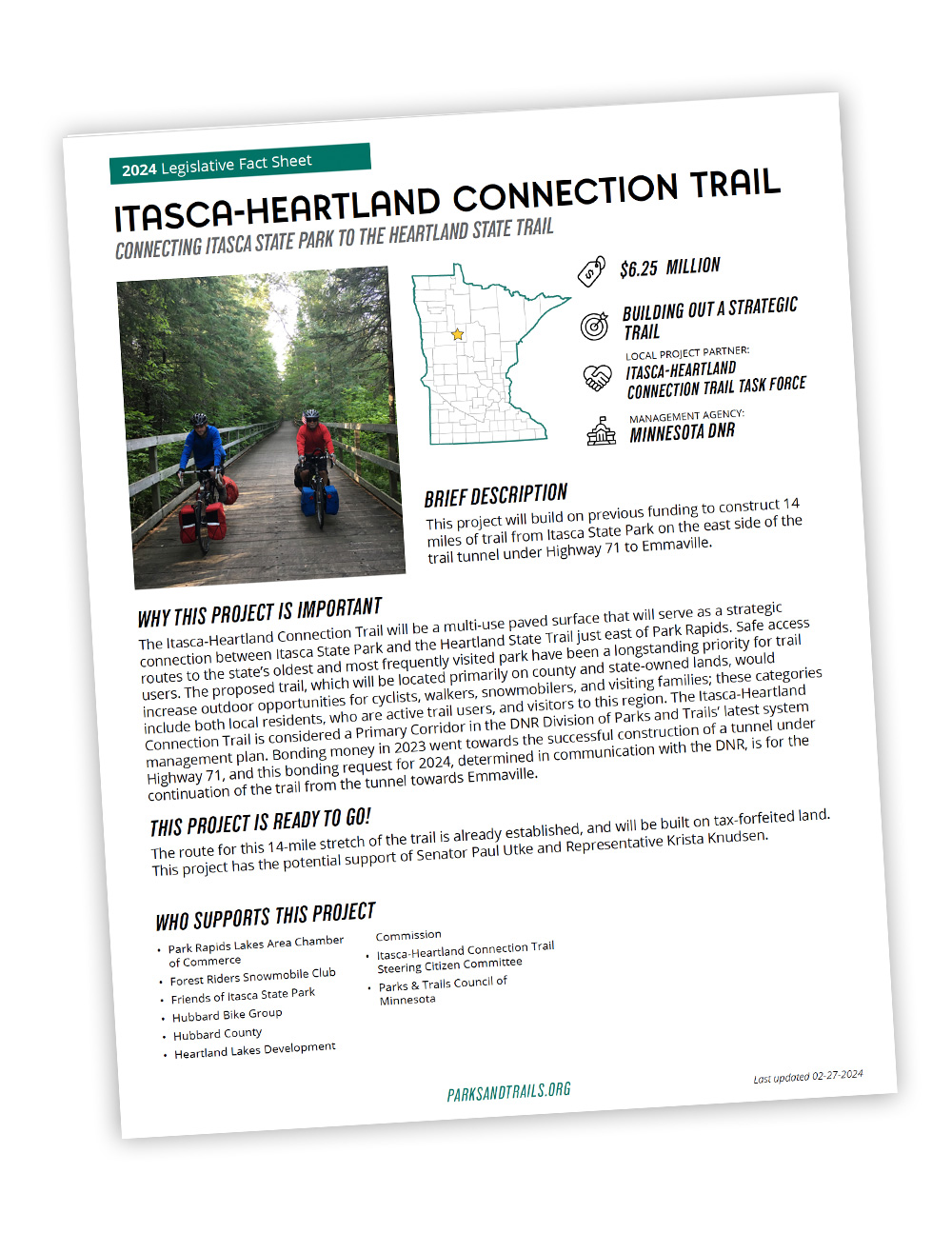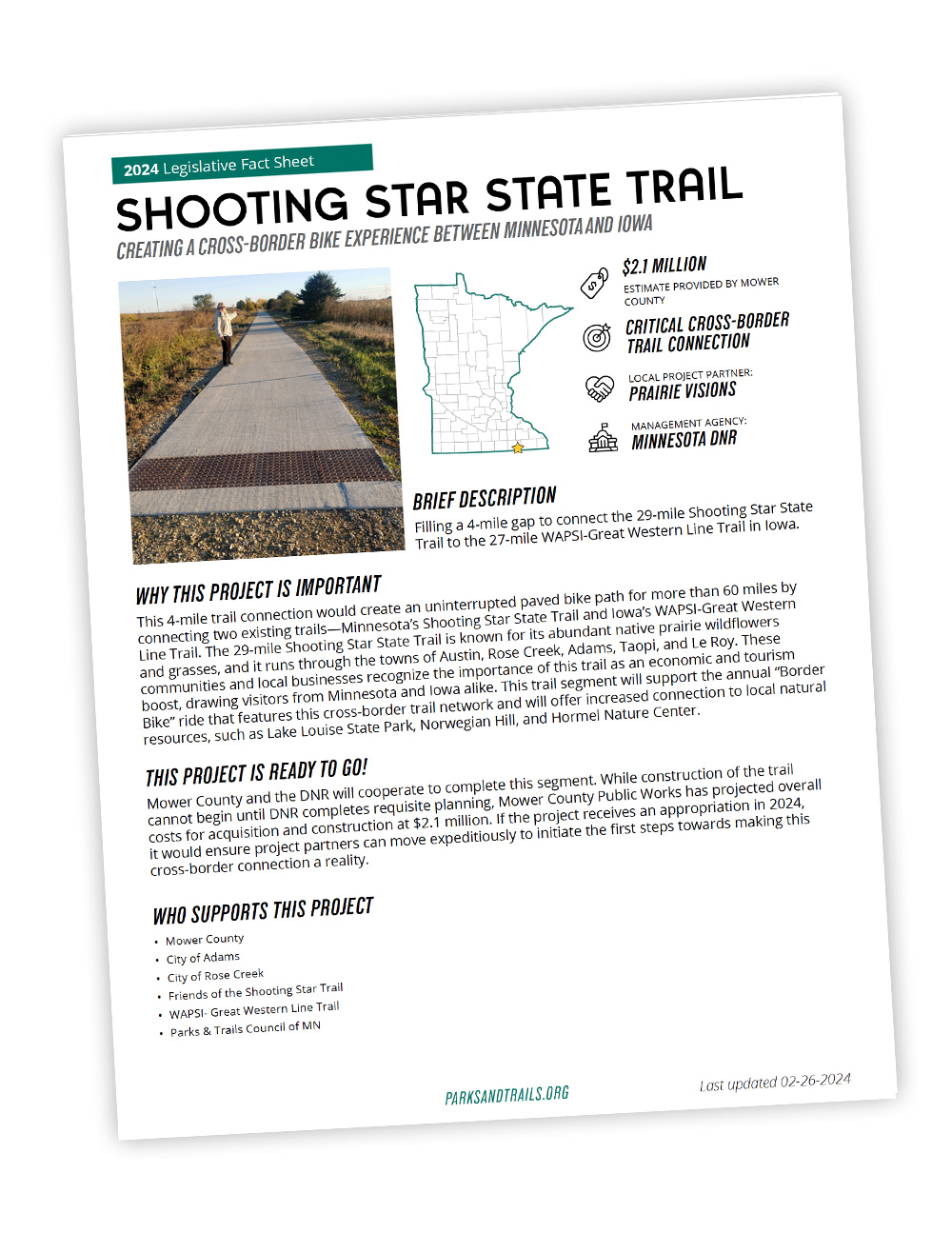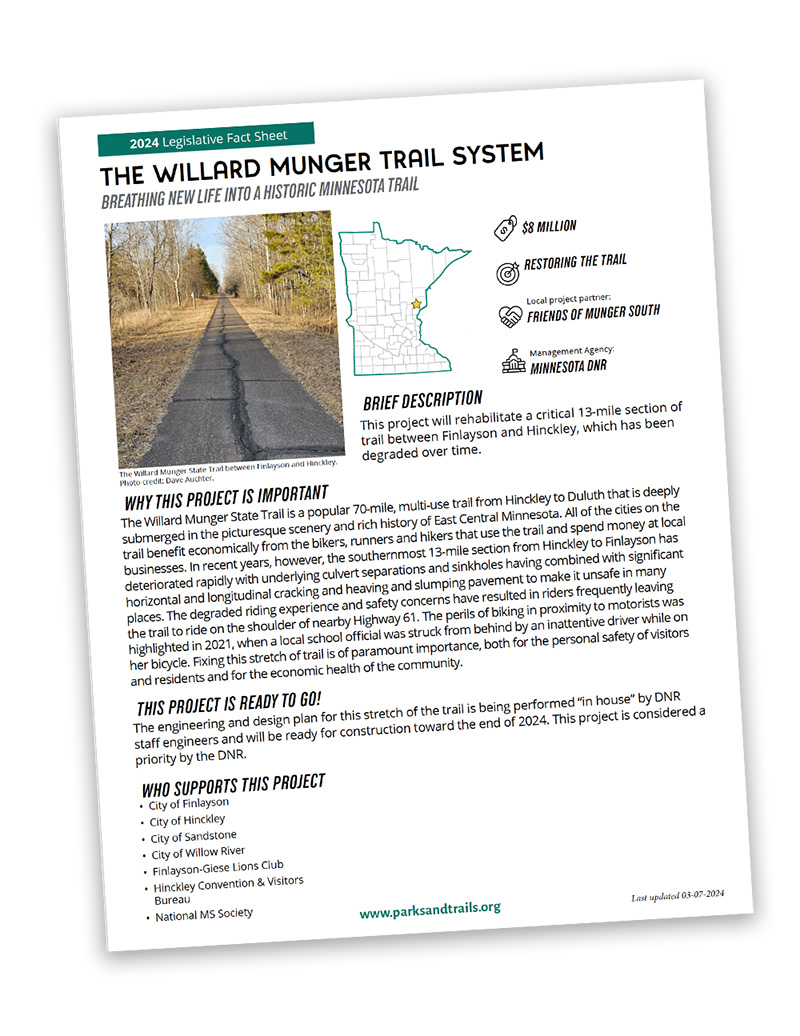
2024 LEGISLATIVE PRIORITIES
Our priorities for this session include:
Funding Issue
Fix crumbling trails, roads & bridges, outdated water systems, and more
We support funding capital improvement projects for parks and trails by using bonding, and the Environment and Natural Resources Trust Fund.
Historically, Minnesota has not invested sufficient resources to keep capital assets within parks and trails in acceptable condition. As a result, the deferred maintenance backlog continues to grow. We urge the legislature to pass a bonding bill and a Legislative-Citizen Commission on Minnesota Resources bill that addresses the urgent needs identified by the agency staff.
Understanding DNR bonding requests
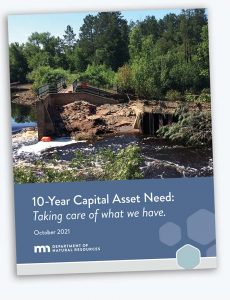 The DNR operates 7 divisions, including the Parks and Trails Division. DNR bonding requests are made for the entire agency and don’t include publicly accessible priority lists of specific projects. P&TC has been encouraging the DNR to share their internal priority lists much like other state agencies do as part of their biennial bonding requests.
The DNR operates 7 divisions, including the Parks and Trails Division. DNR bonding requests are made for the entire agency and don’t include publicly accessible priority lists of specific projects. P&TC has been encouraging the DNR to share their internal priority lists much like other state agencies do as part of their biennial bonding requests.
While we appreciate the DNR’s 10-year Capital Asset Needs report, the agency’s biennial bonding requests do not go into the level of specificity P&TC believes would help lawmakers and the public understand specific priorities for parks and trails that would be addressed if the DNR received the requested appropriation. For example, rather than publishing a specific list of park, trail, bridge or other infrastructure projects, the DNR’s agency-wide requests are lumped under broad and generic headings like: buildings; bridges; and roads and trails; with no clarity as to how the money will be spent for those particular categories of investments.
These needs include:
MN State Park and Trail System | $100 million
$46.4 million | Campsites, Group Camps and Day Use Areas
The MnDNR manages over 5,300 campsites at state parks, state rec areas and forest rec areas, as well as 107 group camps and 64 day-use areas. Many of these facilities are more than 50 years old and in need of major renovations to address deferred maintenance, conform to current standards and meet changing recreational needs.
This funding will address extensive deferred maintenance and meet the changing needs of the public by refurbishing campgrounds and group camps, providing amenities such as accessible vault toilets, modern shower buildings, electric hookups, water lines and drinking fountains, picnic tables, fire rings, and broadband/wi-fi. It would also fund improvements to campgounds to provide more separation between user groups.
$17.2 million | Buildings and Accessibility
Many DNR buildings and facilities were built before the advent of state and federal accessibility standards. The DNR has been partnering with the Minnesota Council of Disability to identify opportunities to enhance accessibility.
This funding will enable the DNR to complete accessibility improvements to high-use facilities such as bathrooms, parking areas, showers campsites, trails, and a variety of day-use and interpretive facilities, as well as provide new amenities to meet the needs of an increasingly diverse user base with a variety of physical abilities and skills.
$7.8 million | Park and Trail Bridges
The MnDNR owns and maintains 128 pedestrian and vehicle bridges within state parks, rec areas and scientific and natural areas (SNAs). DNR’s bridge engineers provide asset management services for DNR-owned bridges. These services include periodic inspections, data management, recommendations on routine maintenance, etc. In the past few years, DNR has experienced significant issues with several aging bridges.
In particular, the High Falls Bridge at Tettegouche State Park must be replaced as it was permanently closed in 2023 due to age and flood damage.
$9 million | Water and Wastewater Systems
Because state parks are generally located outside municipal service areas, wells and onsite water and wastewater treatment systems are required. The average useful life for these amenities is 40 years. In addition, these aging systems are often designed to outmoded standards (including hazardous confined spaces), and have been expanded in a piecemeal fashion over decades. This results in significant safety, operational and maintenance challenges.
The MnDNR has identified some priority sites in need of funding as:
- Itasca State Park
- Lake Bemidji State Park
- Fort Snelling State Park.
$9.6 million | State Trail Rehab*
Trails need regular maintenance to remain as vital assets that Minnesotans can rely on for our well-being and transportation. Parks & Trails Council’s extensive research has validated this recommendation for a sustainable maintenance plan for state trails. > View our State of the Trails page for more details about the current conditions and models for how often trails need maintenance and rehab.
Priorities identified by the MnDNR in the funding request are
- Glacial Lakes State Trail
- Paul Bunyan State Trail
- Luce Line State Trail
- Shooting Star State Trail
- Willard Munger State Trail
$10 million | Land Acquisition
To acquire strategic in-holdings for state parks and recreation areas, and high-priority parcels for state trails and public water accesses.
Metro Regional Park and Trail System | $15 million
$15 million | System Improvements
This request would be allocated to maintain, expand, and improve the Metropolitan Regional Parks System, which consists of 54,000 acres of parks and over 400 miles of interconnected trails. The program funds regional parks and trails that provide recreational services similar to those provided in state parks that are located largely outside of the 7-county region.
The Metropolitan Council will match $15 million of state bonds with $10 million in regional funds for a total Regional Parks System capital investment of $25 million. All these funds would be allocated to implementing agencies (e.g., Three Rivers Parks, Dakota County Parks, etc.).
Local and Regional Parks and Trails Across Minnesota | $4 million
$4 million | Grant Programs
Funding to provide the MnDNR with funds to administer five competitive grant programs, which were established in M.S. 85.019 and designed for local governments across the state to acquire and develop parks and trails.
- Outdoor Recreation Grant Program helps local governments acquire, develop and/or redevelop close-to-home outdoor recreation facilities.
- The Regional Park Grant Program helps local governments acquire shore land, natural areas and threatened habitat, and develop and rehabilitate natural resource-based outdoor recreation facilities of regional significance.
- The Natural and Scenic Area Grant Program helps local governments and school districts acquire and protect natural and scnic areas statewide that are diminishing due to development, especially in high growth areas, shore lands, bluff tops and areas where land use changes may limit future opportunities.
- The Local Trail Connections Grant Program provides grants to local units of government to develop and acquire trail connections to residential areas, schools, workplaces, community centers, recreation areas, trails and parks.
- The Regional Trail Grant Program provides grant to local units of government for development and acquisition of regional trails outside of the metropolitan area.
This funding request is also supported by the nonprofit Greater Minnesota Parks and Trails.
Friends Group Support
Our Friends Group Partners supporting this issue:
- Friends of Bertram Regional Park
- Friends of the Casey Jones State Trail Association
- Glendalough Park Partners
- Friends of Nerstrand Big Woods State Park
- Friends of the Shooting Star Trail
- Sibley State Park Improvement Association
- Friends of Tettegouche State Park
- Friends of Whitewater State Park
- Back Country Horsemen of Minnesota and of Zumbro Bottoms
- Friends of Lake Maria State Park
- Friends of Anderson Park
Funding Issue
Invest the Surplus in Parks and Trails
We encourage using a portion of the state surplus on park and trail improvements.
Minnesota has a projected $3.715 billion surplus. Meanwhile, funding for Minnesota’s State Parks and Trails has not kept up with a growing system and increased demand. Investing a portion of this surplus into Minnesota State Parks and Trails would help keep them healthy and accessible to all.
Friends Group Support
Our Friends Group Partners supporting this issue:
- Friends of Bertram Regional Park
- Friends of the Casey Jones State Trail Association
- Glendalough Park Partners
- Friends of Nerstrand Big Woods State Park
- Friends of the Shooting Star Trail
- Sibley State Park Improvement Association
- Friends of Tettegouche State Park
- Friends of Whitewater State Park
- Back Country Horsemen of Minnesota and of Zumbro Bottoms
- Friends of Lake Maria State Park
- Friends of Anderson Park
Policy Issue
Off-highway vehicles (OHVs) do not belong in state parks
We oppose all efforts to introduce or expand the use of motorized, off-highway vehicles in state parks and alongside state trails.
Friends Group Support
Our Friends Group Partners supporting this issue:
- Friends of Bertram Regional Park
- Friends of the Casey Jones State Trail Association
- Glendalough Park Partners
- Friends of Nerstrand Big Woods State Park
- Friends of the Shooting Star Trail
- Sibley State Park Improvement Association
- Friends of Tettegouche State Park
- Friends of Whitewater State Park
- Back Country Horsemen of Minnesota and of Zumbro Bottoms
- Friends of Lake Maria State Park
- Friends of Anderson Park
Policy Issue
Welcome diversity, equity and inclusion
We encourage legislative efforts to develop programs that welcome more Black people, Indigenous people, and people of color communities into parks and trails.
Friends Group Support
Our Friends Group Partners supporting this issue:
- Friends of Bertram Regional Park
- Friends of the Casey Jones State Trail Association
- Glendalough Park Partners
- Friends of Nerstrand Big Woods State Park
- Friends of the Shooting Star Trail
- Sibley State Park Improvement Association
- Friends of Tettegouche State Park
- Friends of Whitewater State Park
- Back Country Horsemen of Minnesota and of Zumbro Bottoms
- Friends of Lake Maria State Park
- Friends of Anderson Park
Funding Issue
Community-driven park and trail projects
We support our Friends Group Partners in advocating to build trails in their communities.
Local volunteer groups often play a critical role in developing state and regional trails. At Parks & Trails Council, we support these volunteers by providing technical assistance to help navigate the legislative process. We are building on our 2023 successes, which secured funding for six trails.
In 2024, we are partnering to secure funding for these four critical projects
| Trail | Project Summary | Funding Source | Funding Amount Requested |
| Casey Jones State Trail | Rehabilitate the existing three miles of trail east of Pipestone and several miles of a segment within Lake Shetek State Park. | Bonding Bill | $3.15 million |
| Gitchi Gami State Trail | Improve accessibility and conditions at a trailhead and along seven miles of the Gitchi-Gami State Trail between Gooseberry Falls and Split Rock Lighthouse State Parks. | Bonding Bill | $1.5 million |
| Glacial Lakes State Trail | Complete a multi-year effort to build 4.2 miles of trail connecting the Glacial Lakes State Trail in New London to Sibley State Park. | Bonding Bill | $4.263 million |
| Heartland (Itasca Spur) State Trail | Contribute toward building 14 miles of trail from Itasca State Park to Emmaville. This segment will make use of the trail tunnel recently constructed under Highway 71. | Bonding Bill | $6.25 million |
| Shooting Star State Trail | Fill a 4-mile gap to connect the 29-mile Shooting Star State Trail to the 27-mile WAPSI-Great Western Line Trail in Iowa. | Bonding Bill | $2.1 million |
| Willard Munger State Trail | Rehabilitate a 13-mile section of trail between Finalyson and Hinckley, which has been degraded over time. | Bonding Bill | $8 million |
